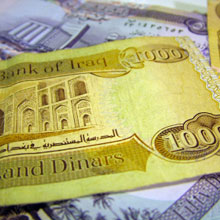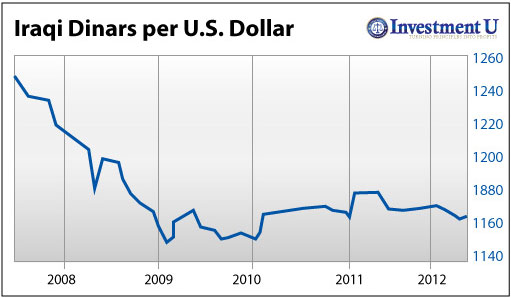Article by Investment U

The State of Washington, among other responsible parties, is sick of folks getting burned on the Iraqi Dinar and other foreign exchange scams. So are we…
Amman, Jordan has some of the worst traffic I’ve ever seen. Swarms of cars zoom around traffic circles that were meant to create a street scene like London’s and, maybe, a sense of order.
The funny thing about this Middle Eastern capital’s hustle and bustle is how much of the movement is dominated by cars with Iraqi license plates. Land Cruisers, Infinitis, Benzes…
They’re nice cars – the cars of the people who could afford to get the heck out of Dodge at a time when even sitting on the world’s fifth-largest oil reserves couldn’t make staying worthwhile. Things have gotten awfully hairy over the past decade in Mesopotamia, and even with improvements, it’s one of the most dangerous places in the world.
Nevertheless, you may have heard or seen some recent hype surrounding Iraq’s currency, the dinar. Some heavy spenders are bullish on the dinar, considering it a bet on a young democracy with a major natural resource bounty. These loud voices in the online forex world claim to be riding a wave only a fool would miss.
Well, to paraphrase an old American saying, if you’ll buy the dinar, I’ve got a bridge in Baghdad to sell you!
The Sad Truth About Iraq’s Growth Prospects
Those heavy spenders are in fact shelling out big money to grab your attention on Google and other search engines as you check to see what’s up with Iraq.
They want to catch you at the door of the digital library before you read too much, because there’s a sad truth that undermines Iraq’s growth prospects.
That activity created by Iraqi refugees isn’t limited to Amman. Political and commercial centers around the region still buzz with Iraqi professionals, nearly a decade after the U.S.-led invasion that toppled Saddam Hussein’s dictatorship.
More than half a million Iraqis sought refuge in Jordan since 2003, and over twice that number fled to Syria. They’re shopkeepers and accountants, doctors and janitors. They’re also pieces of the economy that’s supposed to profit enough to make the Iraqi dinar a good investment. The U.N. reports that Iraqi refugees who returned home aren’t happy about it.
They’ve got some decent points to make, these forex hype artists: Iraq’s Central Bank recently cut the dinar loose from its peg of 1170 to the U.S. dollar. After being locked there since January of 2009, it’s risen a tidbit to 1160 per USD.
Iraq’s oil production is also back to pre-war levels, according to the CIA World Factbook. However the snoops’ encyclopedia doesn’t say whether those pre-war levels account for sanctions on Saddam before his ouster.
Iraqi petroleum output, essentially dormant because of danger these many years, is set to rise to 2.6 million barrels a day in 2012. Great news!
False Logic…
The salesmen have these points to make… but they often don’t make them. Instead, they lead with generalities and investment logic that isn’t logical at all.
“Don’t miss this opportunity to profit from Iraq’s developing democracy!” one insists.
Is that enough for you? Why don’t you invest in the island nation of Vanuatu? Its sandalwood-backed currency is the vatu and it’s a blossoming parliamentary democracy. To boot, its name isn’t synonymous with military disaster, horrific civil war and economic disorder.
Foreign exchange opportunists will gladly give you dinars for dollars… and some of them are so willing to do this deal, they’ll trade it to you in person.
In person! As in cash-on-delivery! Have you paid for anything at all COD in the past 20 years, much less a stack of money from a mess of a country?
Take a look at this chart:

Would this excite you if it were a stock? Granted, the downward movement here shows that the dinar is gaining strength against the dollar. And you’re right to note that it’s trading sideways, which can be a sign of a breakout.
But buying dinars really can be thought of as buying stock in Iraq, and Iraq’s a “company” with unstable leadership, no clear economic policy and plenty of rubble to deal with.
The State of Washington, among other responsible parties, is sick of folks getting burned on the dinar and other foreign exchange scams.
So are we…
Buyers of these dinars don’t know what they’re getting, even when the dealer has an easy-to-obtain U.S. Treasury Money Services Business certificate. What’s worse is that there’s no way you’ll be made whole if you get burned.
Foreign exchange means “exchange” in two ways: First, you’re exchanging one currency for another in hopes that the one you buy will appreciate in value against the one you sell. You can also bet the opposite way, of course.
Exchange is also a big word because currency moves on exchanges just like stocks do. You can trade some euros at the local bank for dollars when you come back from a nice trip, but you can’t do the same in dinars.
In fact, you have to be in Iraq to redeem dinars. Needless to say, we wouldn’t advise showing up in Baghdad with a suitcase of precious paper.
Instead, we advise looking into the many thousands of opportunities to make money from the world’s most dynamic economies that won’t leave you broke or dead.
Go long on fast-growing economies by investing money you know, in investments you know even better.
We’ll help you get around the obstacles along the way, in whatever form they take.
Good Investing,
Sam Hopkins
Article by Investment U


 Tradervox (Dublin) – Mark Carney, the BoC governor have showed optimism about the country’s economic performance as well as indicating that the global economy is on a positive trend. Speaking in Waterloo, Ontario, the governor said the nation’s economy had performed better than it had been expected due to the favorable global financial markets and external headwinds abated.
Tradervox (Dublin) – Mark Carney, the BoC governor have showed optimism about the country’s economic performance as well as indicating that the global economy is on a positive trend. Speaking in Waterloo, Ontario, the governor said the nation’s economy had performed better than it had been expected due to the favorable global financial markets and external headwinds abated.

